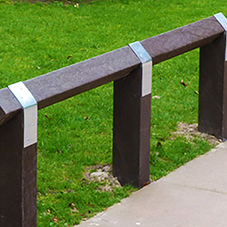When winter sets in, icy paths, roads and car parks quickly become a daily worry. In the UK, councils grit main roads and some public pavements, but coverage is limited and unpredictable. For businesses, schools, community groups and even homeowners with long driveways or private roads, relying on the council alone often leaves gaps.
That is where grit bins come in, providing a ready supply of rock salt or grit, allowing you to treat icy surfaces quickly and safely. In this guide we look at what councils provide, where the gaps are, and why investing in your own recycled plastic grit bin could save you time, money and stress when the frost sets in.
What Do Councils Provide in Winter?
Local councils across the UK are responsible for keeping priority routes safe during winter. This usually includes:
Main roads and bus routes
Access routes to hospitals
Key commuter routes
Most councils also provide public grit bins at set points, often at the top of hills, junctions or in areas where ice is a recurring hazard. These bins are filled at the start of winter and may be refilled if supplies allow. Councils usually make it clear that grit bins are for use on public roads and pavements, not for private driveways, business car parks or school grounds. Supplies are limited, and once a bin is empty, refilling can take days or even weeks depending on demand and budget. So while council grit bins are useful for general safety in your area, they are not designed to cover private property or guarantee supply when you need it most.
Who Should Consider Buying a Grit Bin?
A private grit bin is a practical investment for anyone responsible for keeping people safe on surfaces the council will not cover. Examples include:
Schools: Playgrounds, entrances and car parks must be safe for children, parents and staff. Slips on icy ground can easily lead to injury.
Businesses: From office car parks to retail sites, keeping access routes safe is part of the duty of care. Customers and employees alike need confidence in safe access.
Community centres and places of worship: These venues often welcome people from vulnerable groups who are more at risk of injury in icy conditions.
Care homes and medical facilities: Safe, clear access is essential for residents, visitors and emergency services.
Homeowners with long drives or private lanes: In rural areas, waiting for council gritters is rarely an option. A personal grit bin means you can act straight away.
Benefits of Owning Your Own Grit Bin
1. Immediate access to grit
No waiting for council bins to be refilled or gritters to arrive. When frost or snow hits, you can treat the surface right away.
2. Improved safety and reduced liability
Slips and falls are one of the most common winter accidents. If you are a business, school or landlord, having grit on hand helps fulfil your duty of care and may reduce the risk of legal claims.
3. Long-term cost saving
The initial investment in a grit bin and rock salt is small compared to the cost of accidents, lost business due to closures, or call-outs for emergency gritting.
4. Reliability
Grit bins from Kedel are made from tough, recycled plastic that does not rot, rust or crack in freezing conditions. Unlike wooden or metal bins, they are built to withstand year after year of harsh winters. Explore our full range of grit bins.
5. Environmental benefit
By choosing a recycled plastic grit bin, you are reducing demand for virgin materials and helping to repurpose waste plastic into something durable and useful.
How to Choose the Right Grit Bin
Not all grit bins are the same, here are key points to consider when selecting the right one for you:
Capacity: Smaller bins of around 60 litres suit home driveways. Larger bins of 200–400 litres are ideal for schools, businesses and car parks.
Durability: Plastic bins outperform wooden or metal ones in wet, freezing conditions. Recycled plastic bins from Kedel will not split, warp or rust.
Accessibility: Look for bins with wide openings and secure but easy-to-use lids. This makes it simple to grab grit quickly on icy mornings.
Security: Lockable options are available to prevent unauthorised use or theft of grit supplies.
Visibility: Bright colours such as yellow help bins stand out, even in snow.
Storing and Using Your Grit Bin
Once you have chosen your bin, it is important to use it effectively.
Placement: Keep it near the area you need to treat most often, such as a car park entrance, footpath or driveway slope.
Keep it stocked: Fill with rock salt or grit at the start of winter. Top up during the season so you do not run out.
Use correctly: Spread grit thinly and evenly. A small amount goes a long way in breaking up ice and providing traction.
Maintenance: Recycled plastic grit bins require no painting or staining. Just check the lid opens freely and give it a quick clean now and then.
Common Questions About Grit Bins
Do I need permission to install a grit bin?
On private land, no permission is needed. If you want one on a public pavement or roadside, you must apply to the council.
How long does grit last in the bin?
Rock salt stores well if kept dry. A bin with a secure lid will protect it from rain and snow.
Is grit different from rock salt?
In the UK, “grit” usually refers to rock salt. It works by lowering the freezing point of water, making it harder for ice to form.
What size bin is best for me?
Homeowners with short driveways can usually manage with a 60–100 litre bin. Schools, businesses or community centres are better served by larger 200–400 litre bins.
Council gritters and public grit bins play an important role in keeping the UK moving through the winter, but they do not cover every surface or guarantee supply when you need it most. For anyone responsible for private property, from schools and businesses to homeowners with long driveways, having your own grit bin is a simple, effective way to stay in control. Kedel’s recycled plastic grit bins are tough, weatherproof and available in a range of sizes to suit every need. By investing in one now, you will be ready when the temperature drops, ensuring safe access for everyone who uses your space.
Learn more
Is it worth investing in a private grit bin?
| T | (01282) 861325 |
|---|---|
| E | sales@kedel.co.uk |
| W | Visit Kedel Limited's website |
| Oswald Street, Burnley, Lancashire, BB12 0BY |
Products by this Company
Categories
Grit bins Litter bins Storage bins




